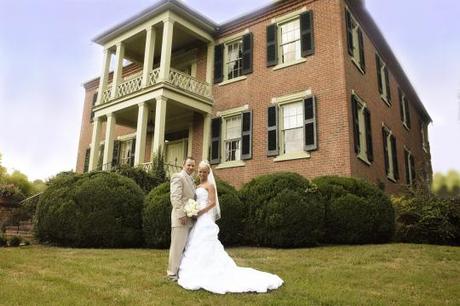
Lana Kiser Photography
New Canton Plantation found its beginnings before the Declaration of Independence was a twinkle in Jefferson’s eye. In the mid 1700′s, His Majesty King George II deeded the original tract of 3,000 acres to British loyal subjects Eldridge and Hannibal Hord. At that time, Tennessee was the western frontier, English settlers were surging westward into the new world, warring Indians were poised to the west. Historical accounts do not offer, but one must wonder how The Hord family must have felt as they were just entrusted with a large land grant from King George, and then suddenly finding themselves with George Washington at the helm, neck-deep in the revolutionary conflict against that same king. Apparently the Hord family chose the right side and lived to produce another generation.
Little is known in this relatively quiet period but, a half a century later in 1840, Eldridge and Hannibal utilized twenty-seven slaves to build a pair of 4,500 sq. ft. brick homes, a 7500 sq.ft. Grist mill, a general hardware store, and numerous barns and out buildings. At that time slave holding was not only legal, but was a worldwide commodity. Black and mulatto slaves tended the fields raising corn, tobacco, cutting timber, and running livestock. Water was hand pumped from Hord creek up to a large cistern above the house which provided a crude form of cool running water to those inside the mansion. Interestingly, this cool water supply was used primarily for cooling instead of drinking.
Those servants favored by Mr. Hord held quarters in the basement of the house. Others who tended to the fields or were involved in milling operations, lived in small cabins near the mill.
Back at the mansion, a bedroom above the kitchen with only an outside door is thought to be the house servant’s quarters. Those holding these quarters did the cooking, cleaning and day-to-day tasks associated with the mansion. Immediately below them, the kitchen was the center of constant activity. Cooking, hospitality, butler’s duties, and any duties associated with the mansion itself were executed around the clock. Until 1990 the kitchen was actually bricked off from the living quarters of the mansion because of the enormous heat generated there. Down below at Hord Creek, the mill bustled with trade, milling, locals visiting the local post office and a general store kept patrons supplied with hard to get items such as tools and gunpowder. People traveled from miles around to trade, barter, catch up on happenings, and grind meal; activity was everywhere.
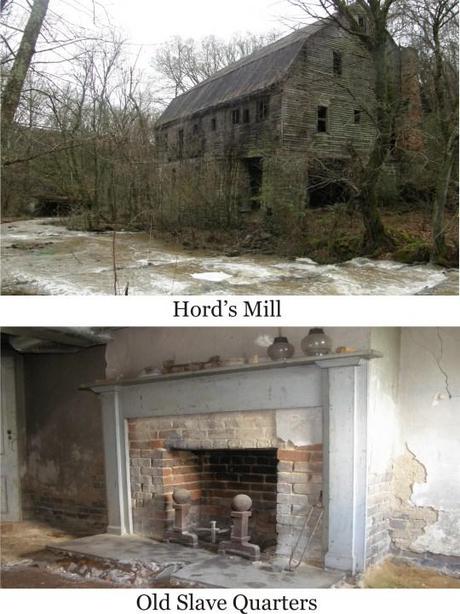
Slave quarters in the basement
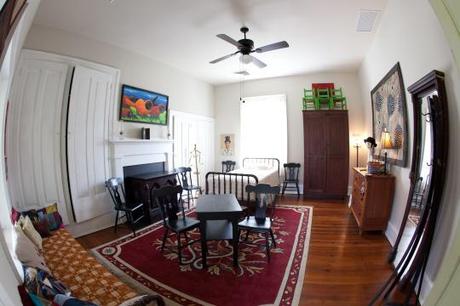
Slave quarters are now groom's dressing room.
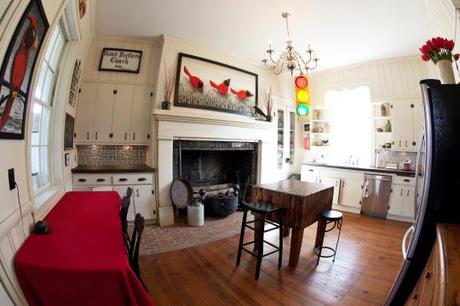
The old dinner bell rang at 12 noon for over 100 years.
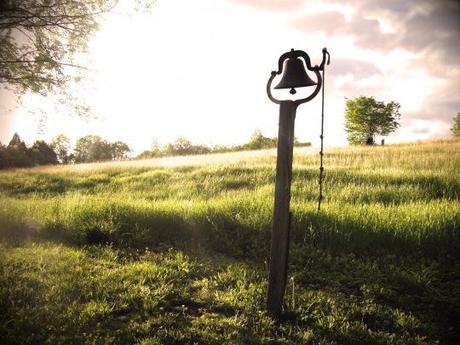
The home’s architecture would be a twinkle in Jefferson’s eye. The style is Federal, whose specific style arrived from across the pond along with our beloved founders. It is of deep European roots and Jefferson’s own Monticello was fashioned in it. The Palladian style is very strict in its use of space and balance, (some suggest even over use and practicality). Jefferson’s extensive travels to France and Italy apparently gave him a deep appreciation for this stately form he found across the Atlantic. Now, back in his beloved America, he loved, built, drew, and promoted this style of architecture. Many examples can still be found from northern Tennessee to Virginia to the many white marble state buildings erected in the capital before the War Between the States.

Foyer
It is often asked, how did the house survive the war of northern aggression? Union troops did indeed occupy the plantation for an extended time. As Union troops descended on the Kingsport area The Hord family hurriedly hid their valuables in nearby caves and sink holes. Union commanders allowed the family to remain in their home while the troops utilized the plantations many facilities. The story is told of a union corporal who demanded the plantation blacksmith re-shoe his horse. Apparently the blacksmith was just as sarcastic as the corporal was arrogant. The blacksmith’s unwelcome comment resulted in him being bayoneted by the angry corporal. The soldier’s commander upon hearing of the wounded blacksmith, assigned his personal doctor to oversee the man’s recovery. It is told that the corporal’s treatment was not so kind. Apparently Mr. Hord’s cooperation with union commanders in offering the plantations facilities to the battle weary troops helped to save the plantation and its assets for future generations. After the union troops continued their march south to Atlanta, valuables were removed from their hiding places and returned to the home. Plantation life would carry on much as it had before.
The plantation home is estimated to have more than a million bricks, each handmade and kiln fired. Even the interior walls are a full 18 inches thick. In response to a challenge from Mr. Hord, the head slave, thought to be Abraham D, oversaw completion of the house in just over a year. His reward was a gold coin and first dance at the annual Christmas party. Interestingly, stories suggest that Abraham chose Mrs. Hord as his dancing partner. Abrahams signature still remains today, carved into the old brick wall near the entrance to his quarters. Abraham’s legend lives long after his passing and he was apparently a wise and faithful servant.
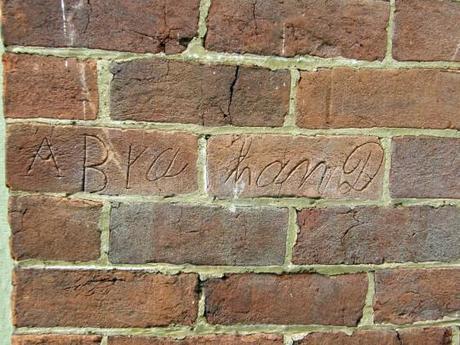
Mr. Hord according to all accounts was a benevolent and decent man. This observation in galvanized into history by the fact that not only did the Hord family agree to the decree of emancipation but land plots were provided for those families whose fates he governed in that bloodiest of civil battles. It should not go unmentioned that the American founders were those who first put a stop to this form of human trafficking. It could not be counted the number of times those close to the history of The Plantation have remarked, “if only walls could talk… what they would say”. Then, in 1864 after two years of grim war, and almost two million casualties General Lee and Grant agreed to articles of surrender ending the America’s bloodiest chapter. At the proffer of President Lincoln, those indentured servants caught in the middle of this bloody conflict were granted freedom. Some moved to New Canton where Mr. Hord provided property. Some of these newest American citizens took the Hord name and many of their descendants still live in New Canton today. It is with the upmost respect and honor for all those, indentured or free, remembered and forgotten, those who prospered and those who lay slain in obscurity, that New Canton Plantation still stands to exist as it does today.
For close to two hundred years, the 9 fireplaces churned out heat for those inside, but the dilapidated outbuildings and ruins surrounding the stately old mansion allude to times long since passed. As one walks the property, its trees appear monstrous, their clinging vines, Jurassic. Abandoned roadbeds plead to a curiosity of travels they must have seen, questions left unanswered. New Canton Plantation is not only a home, but a mysterious time all but gone now, just a haunting curiosity, but such is the mystery of history.
The picture of all the old buildings shows the Plantation in full operation around 1900. Interestingly, the difference between a plantation and a farm is that a plantation is 100% self-sufficient, a farm is not. This picture shows the mill, blacksmith’s shop, tannery, and numerous other unidentified buildings. New Canton Plantation was indeed a center of commerce.
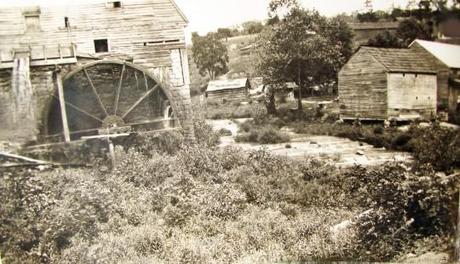
Old Mill, Blacksmith Shop, and Tannery
As far as ghosts, we had heard stories from the previous owners about a soldier in the parlor that had badly frightened the house painter. He would not come back. While visiting, a friend of ours, (and we had told him nothing), saw a soldier pacing between the windows in the parlor. He was wearing an officer’s jacket with buttons, a hat, and a beard. One night at a wedding, a woman from Kingsport approached me quite upset and asked if there was anything peculiar about the parlor. I inquired as to the specifics of her comment and she replied that there was a man in there. I asked her what he was wearing and she said a long dark jacket with buttons up the front, a beard and some kind of hat, like the kind a civil war soldier would wear. She said he was pacing back and forth and was extremely anxious about something. As we stood there, I asked “Where is he now?” She said “Right behind you!“
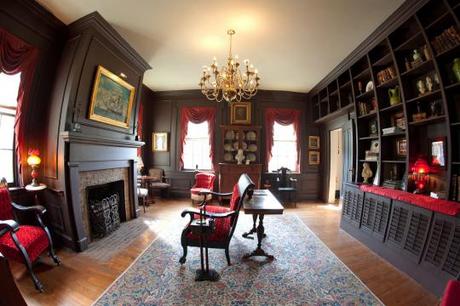
The Library where the soldier has been seen pacing.
We also heard stories of a woman in a white dress. Never thought too much about it until I took the picture attached here. I took 3 or 4 pictures and this is the only one with this girl in the window. I have walked into that house at 2 am and never think twice about it. I think if you want to see a ghost, you’ll see a ghost, if you don’t, you won’t. The only thing I find odd is why do people see the same man in the same room doing the same thing. O well, I’m too busy to worry about it.” – Bill Birdsong, Owner
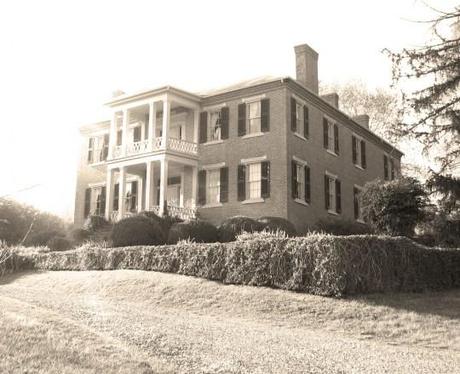
826 WEst Main Blvd.
Church Hill, TN 37642
423-921-4010
Wasn’t that fascinating? What do you think of the girl in the window?
Thanks for stopping by! Tomorrow, come back to read about the historic Martha Washington Inn in Abingdon, Virginia.

